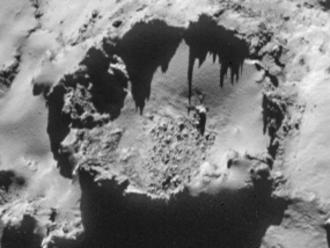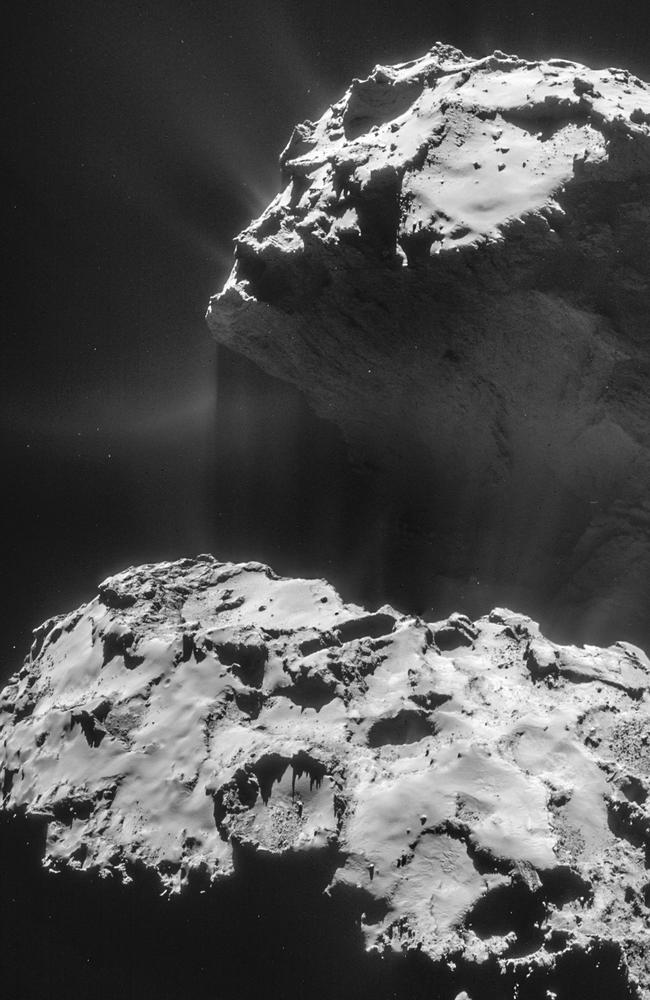FOR the first time in history, we have front-row seats as a long-dormant comet begins to stir. And the view is amazing.
The European Space Agency’s Rosetta space probe has in recent days pulled away from the 28km close orbit of Comet 67P/Churyumov-Gerasimenko it has held for several months.
It is now getting in position for a very intimate Valentines-day encounter: Rosetta will skim past the rubber-duck shaped comet’s surface at just 6km.
It’s because things are getting interesting.
"Jets from Comet Churyumov Gerasimenko" - #67P looking gorgeous in today's @apod: http://t.co/w4QwIJ8mKI pic.twitter.com/tGJQ8YWz71
— ESA Rosetta Mission (@ESA_Rosetta) February 3, 2015There’s quite a show developing.
As the sun begin to warm the bundle of ice and rock, a sleeping beast has begun to awake.
Jets of gas are starting to vent.
At the moment they’re little more than whiffs of vapour. As the comet continues to close with the sun, these will erupt into plumes hundreds of kilometres long.

DEEP FRIED ICECREAM
It’s an analogy NASA is savouring.
“A comet is like deep fried ice cream,” said Murthy Gudipati of NASA’s Jet Propulsion Laboratory in Pasadena.
“The crust is made of crystalline ice, while the interior is colder and more porous. The organics are like a final layer of chocolate on top.”
He was commenting on a new study of comet chemistry published in The Journal of Physical Chemistry.
It’s ice, but not as we know it.
The ice is so intensely cold, we’re talking -243 Celsius, that it crystallises in different ways to what we experience on Earth.
ESA ANALYSIS: Getting to know Rosetta’s comet
Remember Han Solo being “frozen in carbonite” from the Star Wars movie? NASA reckons it’s more like that.
The sooty-black ice crust is a flash-frozen mix of water vapour, organic molecules and dust forming a super-tough “concrete”.
The interior ice, however, is more like fairy-floss: light and fluffy and filled with pockets of gas.
“Deep fried ice cream is really the perfect analogy, because the interior of the comets should still be very cold and contain the more porous, amorphous ice,” Gudipati said in a NASA release.

CRATERED CLUES
At first glance the pictures of G7P’s surface may look like any other asteroid. It’s just that the craters have a different cause.
They’re not produced by impacts.
They’re the remnants of volcano-like vents of noxious gases and water vapour which spluttered out after 67P’s last pass around the sun 2398 days ago.
One clue is that the craters’ rims are jagged, sharp. Like tears in the surface of broken plastic.
These fragile shards of ice are tens of metres high. And they won’t be there for long.
The sun’s warming will soon see them blasted into smithereens — only to be replaced by new structures as the comet returns to deep space.
UP CLOSE AND PERSONAL
On February 14, 11:11pm Adelaide time, Rosetta will swoop down for an ultra-close look at the stirring giant.
It’ll be an 130,000km/h encounter.
It’s a carefully calculated event. There’s little chance of damage, at this stage, from the volatile comet’s gas.
“The upcoming close fly-by will allow unique scientific observations, providing us with high-resolution measurements of the surface … giving us the opportunity to sample — taste or sniff — the very innermost parts of the comet’s atmosphere,” Rosetta project scientist Matt Taylor told media.
Moving into a new path today & swooping in to just 6km from surface of #67P on 14 February http://t.co/kEMyFKEUSZ http://t.co/Rn9RhgjfSt
— ESA Rosetta Mission (@ESA_Rosetta) February 4, 2015In particular, scientists are hopeful the close pass will give them some insight in to how the jet vapours interact with the comet’s coma — a cloud of water and dust which surrounds the solid core.
After this encounter, Rosetta will settle back into a more secure orbit to observe the ever-increasing activity of the comet over the coming months.
HIGH HOPES FOR PHILAE
Hopes remain that the lost lander deployed by Rosetta three months ago will eventually be exposed to the sun. Once its solar cells recharge its dead batteries, it is expected to “phone home”.
This is expected to happen some time in May or June, when the region the probe sits in turns to face the sun.
The little lander touched down on the comet, but struck an unexpectedly dense patch on the comet’s surface. It bounced into the shadow of a crater wall. Within hours, it was unresponsive.
More parting shots of @Philae2014 on #cometlanding day, now with 19 images! Watch animation: http://t.co/lz7FZZuuAr pic.twitter.com/pIEBx7twWU
— ESA Rosetta Mission (@ESA_Rosetta) January 30, 2015Scientists and amateurs alike have been scouring photographs of 67P for any clue as to where the probe came to rest. So far, its location remains a mystery.
Plans for a dedicated flyby by Rosetta to spot Philae, however, have been abandoned.
It was decided that changing the trajectory of the space probe in its Valentine’s Day plunge was too difficult and too risky.
“There is a reasonable chance that you would not look at the correct place,” Rosetta mission manager Fred Jansen said.



Add your comment to this story
To join the conversation, please log in. Don't have an account? Register
Join the conversation, you are commenting as Logout
Here’s what you can expect with tomorrow’s Parramatta weather
As spring moves into summer what can locals expect tomorrow? We have the latest word from the Weather Bureau.
Here’s what you can expect with tomorrow’s Parramatta weather
As spring moves into summer what can locals expect tomorrow? We have the latest word from the Weather Bureau.